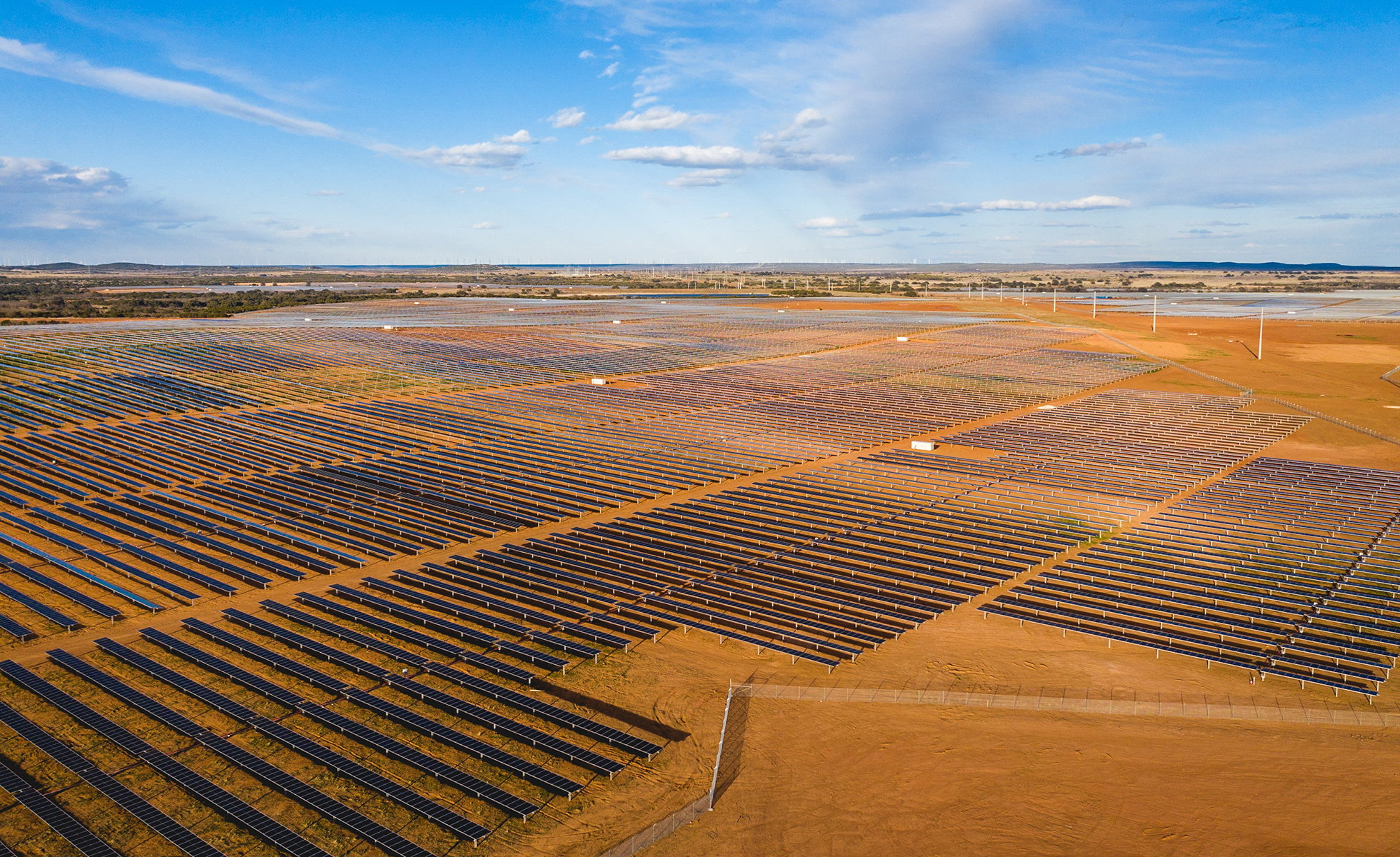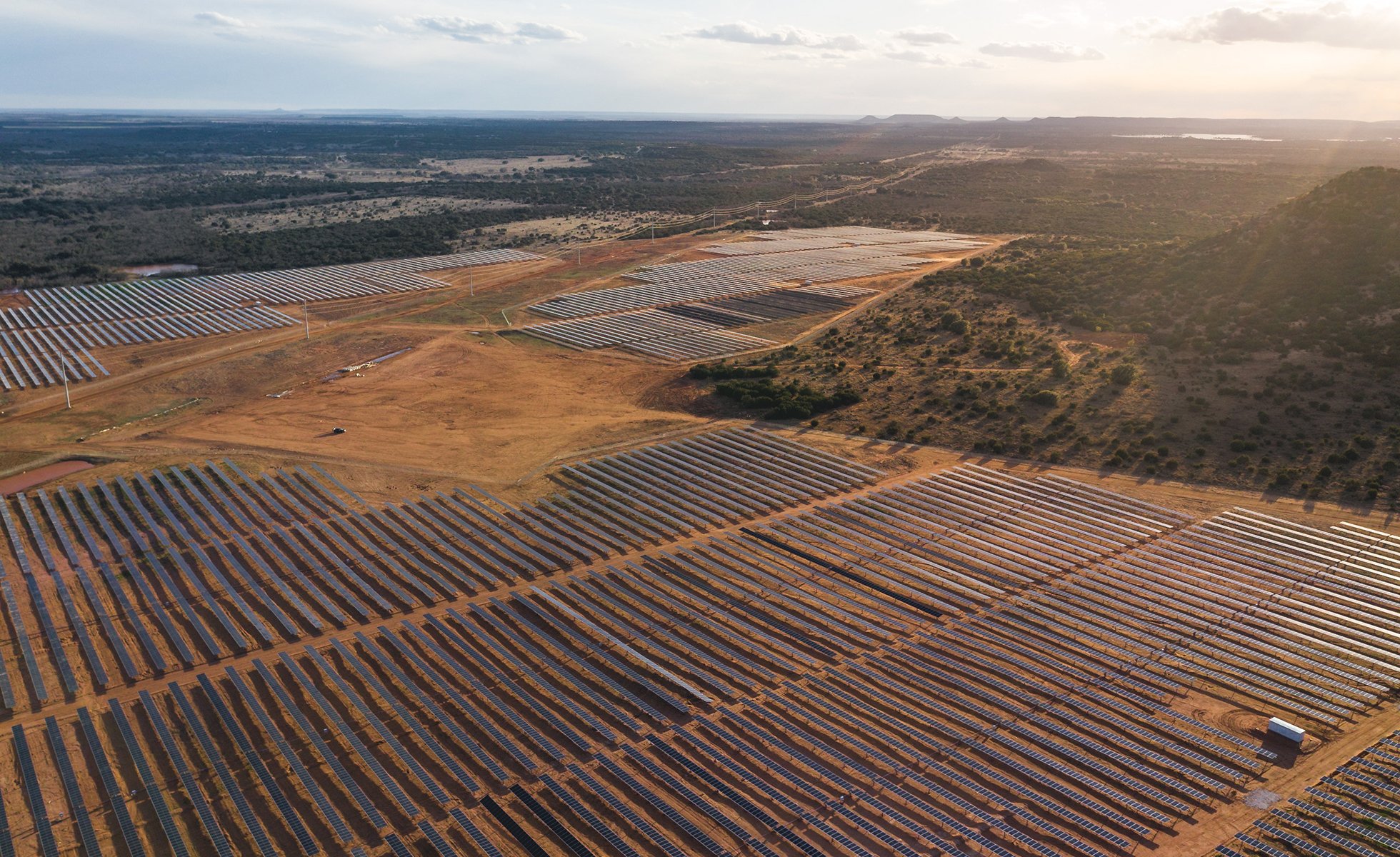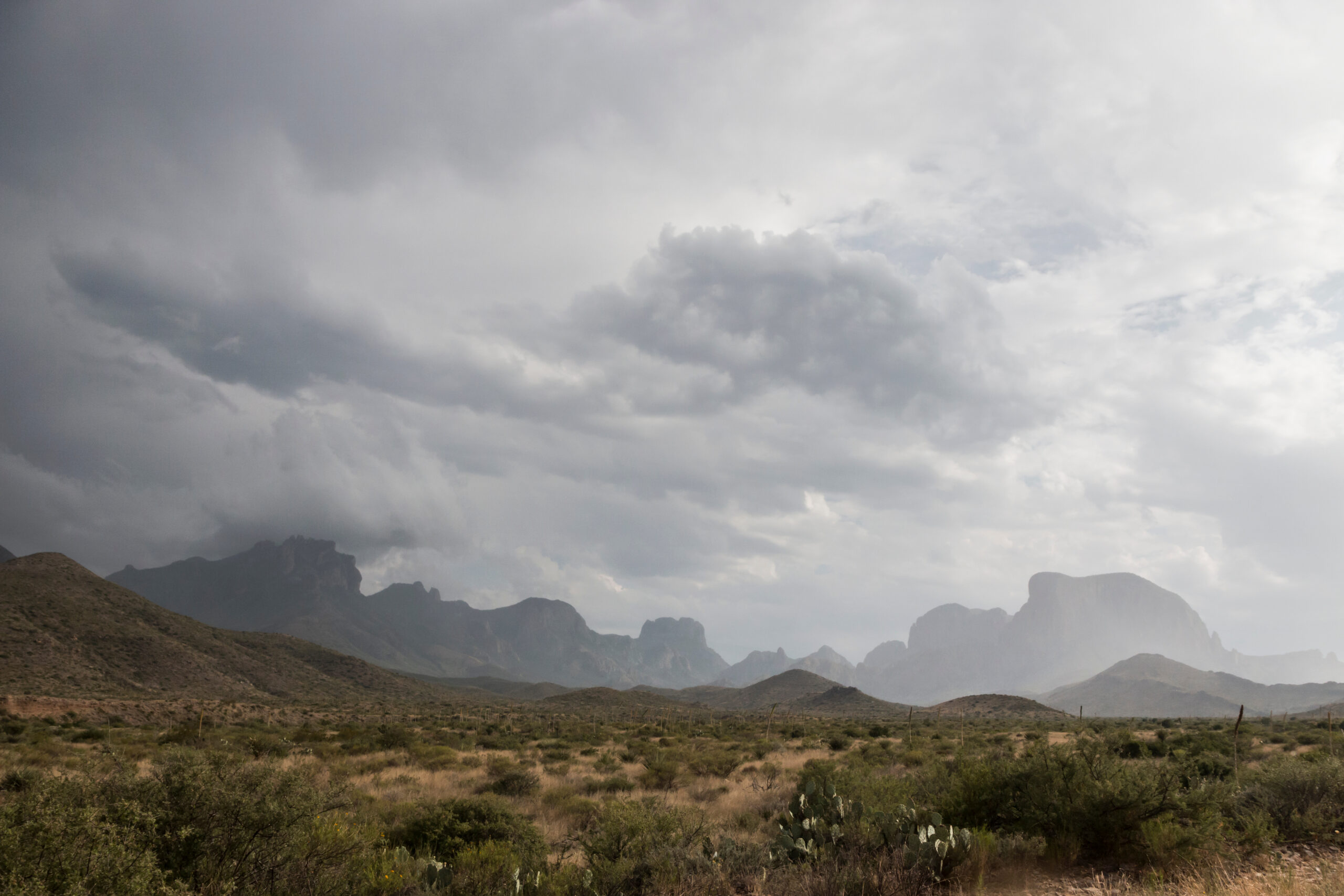
Texas Solar Hits a Turning Point
As the coronavirus pandemic devastates the state’s already flailing oil and gas industry, solar energy production is on a trajectory for record growth.

Above: There are now 17 solar facilities in Texas, including 13 that can produce at least 100 megawatts of power, according to the Solar Energy Industries Association.
On Garland Richards’ ranch in West Central Texas, silicon solar panels spread for two square miles in a shimmering blue expanse that resembles a lake. The Holstein solar farm, which began operating in July in Nolan County, is as long and broad as a small town. The farm has 709,000 solar panels that generate 200 megawatts of electricity, enough to power about 40,000 homes.
Richards leased a tract of his land for the solar farm in hopes that the revenue will pay the taxes on the rest of his property—10,000 acres of cattle country that’s been in his family since the 19th century. “I want to be able to hand the land down to the next generation,” Richards says. “If I can make enough on 1,300 acres to pay the taxes on 10,000 acres, it’s worth it.”
For decades, the 68-year-old former cowboy and his family relied on oil wells that Exxon drilled on the property, which sprawls between San Angelo and Abilene. “But now the oil is depleting, and the market is depleting as well,” he says. In April, oil prices dropped into negative territory for the first time in history as the coronavirus pandemic battered the already beleaguered oil and gas industry. “When oil is negative $47 a barrel, solar looks pretty good,” Richards says.

With intense sun and vast tracts of empty land that can accommodate the huge scale of major solar farms, West Texas has long been primed for rapid solar development. Texas’ free market approach to electricity production and loose regulation of development encourages big electricity projects of any kind, including solar. With technological innovations, the cost of developing solar farms has dropped about 40 percent in Texas in the last five years, according to the Solar Energy Industries Association (SEIA). And once a solar farm is built, it’s inexpensive to operate compared to gas and coal-fired plants, because its fuel is free.
Federal tax credits have further cut the cost of developing solar farms. Meanwhile, demand for solar electricity has increased as both the public and corporations have embraced it as a means of battling the climate crisis. In response, solar farms have begun to proliferate in West Texas. There are now 17 solar facilities in Texas, including 13 that can produce at least 100 megawatts of power, according to SEIA. “Solar has just started to come on big in the last two to three years,” says Rich Clark, an engineer and board member of Solar Austin, a renewable energy nonprofit in Central Texas. “It’s a huge wave that’s coming.”
The solar surge follows the whirlwind growth of the wind industry in West Texas, where the landscape is dominated by towering propeller-like turbines that stretch for miles. For example, Nolan County, with fewer than 15,000 residents, is home to three of the largest wind farms in the world, and it’s recognized globally as a wind energy powerhouse.
According to the Electric Reliability Council of Texas (ERCOT), the nonprofit that oversees Texas’s electrical grid, the state’s utility-scale solar capacity (the big solar farms that connect to the grid) is expected to increase 150 percent this year to 5,777 megawatts. Next year, installed solar capacity is expected to grow more than 130 percent to 13,449 megawatts, according to ERCOT, which relies on information provided by developers.
“They’re looking to purchase solar because it makes economic sense to them. That’s when I feel like you’ve hit that turning point in Texas.”
Momentum has slowed slightly since COVID-19 began spreading across Texas in March, quarantining workers and disrupting supply chains. But unlike the oil and gas industry, the solar industry has not been devastated. “There have been impacts,” says Charlie Hemmeline, executive director of the Texas Solar Power Association. “But big picture, 2020 was slated to be solar’s best year in Texas, and we’re still on track for that to be the case.”
In the last 10 years, Texas had lagged behind other states in terms of solar development, according to SEIA rankings since 2010. But in 2018 and 2019, Texas ranked second in the nation for the amount of solar capacity installed during the year. “It’s really been a sea change for Texas,” says George Hershman, president of California-based Swinerton Renewable Energy, which has eight solar farms in Texas. He says the state “is becoming our biggest solar market.”
Some of Texas’s largest companies, including heavy polluters in the petroleum sector, have begun switching to solar and investing in its development. In 2018, ExxonMobil agreed to use solar and wind power to draw oil from the Permian Basin. Bloomberg reported that it was the biggest renewable deal ever signed by an oil company. In 2019, Facebook agreed to finance construction of the 4,600-acre Prospero solar farm in Andrews County in West Texas. This year, Bank of America announced that it had partnered with the Texas-based Reliant Energy to get electricity from a West Texas solar farm. And Dow Chemical signed an agreement to use a South Texas solar farm to supply its Gulf Coast petrochemical plant, the largest facility of its kind in the western hemisphere.
“When you have these major companies that are not focused on environmental issues deciding to purchase solar, that’s really important,” says Clark, of Solar Austin. “They’re looking to purchase solar because it makes economic sense to them. That’s when I feel like you’ve hit that turning point in Texas.”
Texas cities are also part of the surge. In July, Houston’s city government transitioned to 100 percent wind and solar for all of its operations, including wastewater treatment plants, the zoo, and its three airports. Houston is now the largest U.S. city government powered entirely by renewables. “Cities are being battered by climate change, and we are the first line of defense,” says Houston’s chief sustainability officer Lara Cottingham. “Cities have to step up.”
Despite the momentum of both solar and wind, Texas still produces far more carbon dioxide than any other U.S. state—more than 700 million metric tons every year, about twice as much as the next most highly polluting state, California. Texas’s heavy emissions are owed to its size, industrial production, and sources of electricity.

And even with solar’s growth, it still makes up only about 2 percent of electricity generation in Texas. In comparison, natural gas makes up about 44 percent, wind about a quarter, and coal 16 percent. Experts say it will take time for solar to eclipse other electricity sources, as wind power did after its buildout began more than two decades ago.
But continued rapid solar expansion may also depend on policy makers in Washington and Austin.
Starting in 2006, the federal Solar Investment Tax Credit (ITC) allowed investors in solar projects throughout the U.S. to deduct 30 percent of installation costs from their taxes. The tax credit has driven a 50 percent annual increase in solar installation every year since it was enacted, SEIA reports. But under the policy, the tax credit declined this year to 26 percent and will drop to 22 percent next year. The House included an extension of the higher rate in its new infrastructure bill. But it’s not clear that the extension will remain in any bill passed by the Senate.
“Customers want renewables … but [growth in solar] is also driven by the incentives that are in place,” says Chris Fallon, vice president of renewables for North Carolina-based Duke Energy, which owns the Holstein solar farm on Garland Richards’ ranch. “A lot of what happens with solar development depends on the tax credits.” Although Duke Energy now has four solar farms in Texas, it also owns fossil fuel and nuclear power plants elsewhere in the U.S.
In Texas, solar growth has been encouraged by property tax abatements, which allow developers to pay less in property taxes in exchange for public improvements. During last year’s legislative session, the far-right Texas Public Policy Foundation, a staunch oil and gas ally, campaigned to exclude solar and wind industries from the abatements, even though they’re available to every other kind of developer. The Legislature resisted and the abatements are still in place for solar and wind industries. “But I would anticipate more attacks [on the abatements] in the next legislative session,” says Emma Pabst, an associate at the nonprofit Environment Texas.
“Renewable energy is something that’s going to happen. We will eventually evolve. The petroleum industry will fade away.”
The resistance to renewables comes despite the contribution they make to rural regions like Nolan County, where Richards’ ranch is located. “Until wind turbines came out here, all we had was agriculture and oil, which are not stable,” says Lisa Peterson, the county attorney for Nolan County. “Other industries have come out to take a look, but we have no water, and most industries require water. We can handle these [renewable] industries and survive as a county.”
Over 10 years, she says, the county will receive $1.8 million in property taxes on the Holstein solar farm. Wind farms, meanwhile, have accounted for a huge share—as high as 27 percent—of the property taxes collected by the county over the past decade.
Richards, too, is thinking about survival. His property, which includes Fort Chadbourne, an 1852 military outpost on the National Registry of Historic Places, was once a massive tract covering 150,000 acres. Over the years, his family sold off chunks of land until now 10,000 acres are left. By leasing a tract for the solar farm, he’s trying to avoid yet another division of the ranch.
“I needed to find a way to make this land self-sufficient,” Richards says. “The solar farm is a way to do that. Renewable energy is something that’s going to happen. We will eventually evolve. The petroleum industry will fade away.”
Read more from the Observer:
-
In Harris County, A Group is Working to Expand Voting Access in Jails: The lack of access for eligible voters in pretrial detention is part of a larger constellation of disenfranchisement for people whose lives intersect with the criminal legal system.
-
Houston’s Hot-Stepping Zydeco Dance Fuses Creole and Black Cowboy Cultures: For many of these dancers, musical gatherings are just one aspect of a lifestyle rooted in their Creole heritage: trail riding by day, zydeco dancing by night.
-
Improbable, Prophetic Houston: Two new books about the Bayou City—one about its people, one about its places—explore how the fourth largest city in the U.S. became itself.


